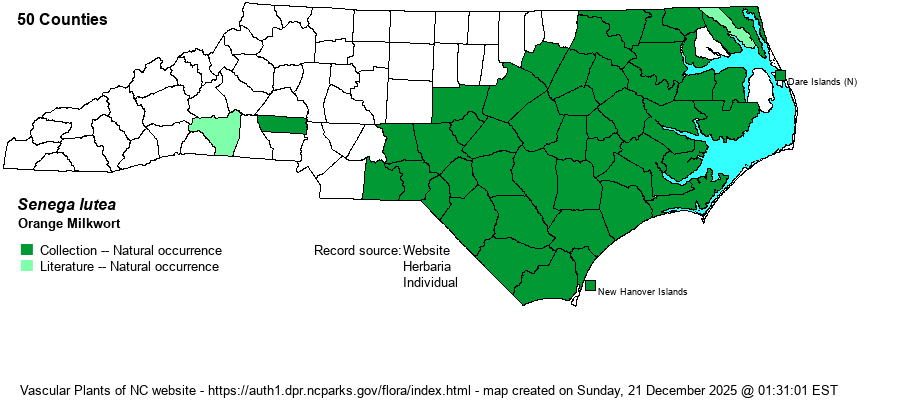| Author | (L.) J.F.B. Pastore & J.R. Abbott | |
| Distribution | Throughout the Coastal Plain, and barely into the southern Piedmont, with an isolated collection record from Lincoln County and a photo record from Rutherford County.
This is a widespread Coastal Plain species, ranging from coastal NY south to southern FL and eastern LA. | |
| Abundance | Common and easily seen in the southern half of the Coastal Plain, at least where Longleaf Pines (Pinus palustris) dominate. Fairly common, at least locally elsewhere, except uncommon in the northeastern counties. Extremely rare into the Piedmont. | |
| Habitat | This is a wetland species of many habitats, in mostly acidic soil. It favors pine savannas, but it occurs in wet pine flatwoods, ditches, pocosin borders, streamhead ecotones, and other wet or damp ground. It is not as strongly confined to savannas as are some Senega species. | |
| Phenology | Blooms from April to October, but more frequently in the spring; fruits soon after flowering. | |
| Identification | This is a very familiar species, known to all biologists owing to its orange flowers and general commonness. It has one to several stems, growing to about 10-12 inches tall, with fleshy basal leaves that are mostly elliptical. The scattered stem leaves are alternate, fleshy, fairly wide for a Senega, being spatulate and about 1 inch long. Topping each stem or branch is a dense ball/head of bright orange flowers, with the head about 1 inch tall and somewhat narrower. Needless to say, when in bloom, the species cannot be confused with anything else, as there are so few NC species with orange flowers. | |
| Taxonomic Comments | All of the former Polygala species in NC have now been moved to the genus Senega in 2023. | |
| Other Common Name(s) | Red-hot-poker, Yellow Milkwort, Bog Cheetos | |
| State Rank | S5 | |
| Global Rank | G5 | |
| State Status | | |
| US Status | | |
| USACE-agcp | | |
| USACE-emp | | |

